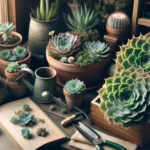Introduction to Sempervivum Black
Imagine a succulent that captures the essence of the night sky, a plant so majestically dark that it stands out like a shadowy gem in a sea of green. Well, gardeners and plant enthusiasts, you don’t have to imagine any longer. Welcome to the world of the Sempervivum black variety. This alluring succulent brings a slice of the extraordinary to any garden, flaunting a color that’s as rare as it is striking. Let’s dive into its obsidian depths and uncover what makes this succulent a must-have for your garden narratives.
Renowned for its resilience and low maintenance, the sempervivum, also known as ‘hens and chicks,’ is the go-to choice for both seasoned growers and rookies. But when you stumble upon the sempervivum black variety, you know you’ve found something truly special. Its rich, dark-hued leaves, which can range from deep purples to almost ink-black tones, create a dramatic contrast against the typical shades of greens and blues found in most succulents.
These ebon beauties are not just about looks, though—they’re hardy warriors, standing firm against the elements, be it scorching sun or frosty nights. So, if you’re eager to learn more about these dark wonders and how to keep them beaming with life, our guide to creating a thriving succulent garden is an excellent starting point.
Did you know that sempervivum black isn’t just a visual delight? It’s also a storytelling plant. Picture this—a centerpiece in your patio garden that sparks curiosity and conversation among your guests. Or perhaps, a mystical touch to your indoor green space that complements modern and minimalist decor. This deviation from the common palette of pastel succulents allows for a bold statement in any plant display.
So, whether you’re looking to add a splash of mystery to your windowsill or aiming for a garden that’s brimming with diversity, the sempervivum black variety is your botanical ticket to an enchanted, somehow lunar landscape, right in your own home. Dive into this dark beauty and let it redefine the green in your green thumb!
Deciphering the Dark Shades
Have you ever gazed upon a garden and found yourself drawn to the enigmatic allure of sempervivum with their nearly black foliage? These rare beauties, cloaked in shades as dark as the night, beckon gardeners and plant enthusiasts alike to explore the myriad of tones they present. It’s a natural phenomenon akin to the velvet drape of the midnight sky, speckled with twinkling stars, transforming your garden into a universe of its own. The variety of dark hues in sempervivum isn’t just about aesthetics; it speaks volumes about the plant’s unique adaptability and evolution.
But what exactly bestows these succulents with such captivating dark tones? The answer lies in a fascinating interplay of genetics and environmental factors. These succulents produce an abundance of pigments like anthocyanins, which not only contribute to their deep coloration but also offer protection from the harsh rays of the sun. It’s a vibrant dance of survival, with pigments acting as the succulent’s natural sunscreen. Imagine these pigments as tiny umbrellas, shielding the plant cells from ultraviolet light and preventing sunburn.
Witnessing these sempervivum varieties flourish in gardens is a testament to their resilience. They seem to relish the warmth of the sun, thriving under its intense glare where other plants might falter. Irrespective of high temperatures and scorching sunlight, varieties like the ‘Sempervivum Black’ not only survive but seem to wear their dark colors like a robe of strength. These hardy succulents require minimal maintenance, yet they deliver a striking visual impact with their dusky foliage and architectural form.
For those who wish to delve deeper into the care for these astounding plants, resources like BBC Gardeners’ World Magazine provide golden rules and expert advice to ensure these dark wonders continue to enchant your garden space. From watering eccentricities to soil preferences, learning the art of cultivating sempervivum will render your garden a sanctuary for these exquisite dark succulents. So embrace the chance to unveil the beauty of these dark-hued wonders, for they are sure to cast a spellbinding effect on any onlooker’s gaze.
Best Varieties of Sempervivum with Dark Tones
Ready to dive into the enigmatic world of dark-hued succulents? Let’s explore the top sempervivum varieties that express their beauty through shades of the night. These aren’t your average green houseplants; they play with the palette of shadows, offering a unique elegance to any succulent collection or rock garden.
If you’re aiming to introduce some gothic chic into your green space, the ‘Sempervivum Black’ variety is a showstopper. With rosettes so dark they appear to absorb sunlight, it’s a true gem among the succulent community. Imagine a corner of your garden that whispers mystery with these dark-toned beauties nestling in between stone pathways.

One must not overlook ‘Sempervivum Arachnoideum’ either, the cobweb houseleek, adorned with a delicate webbing that begs a closer look. This cultivar displays a moody array of purples and deep greens, embellished with web-like filaments that give it a fantastical appearance fit for any fairy-tale garden.
Are you curious about how to care for these alluring plants? Succulents like sempervivum require specific conditions to thrive. A visit to The Ultimate Guide to Succulent Care will ensure your dark sempervivums grow as vibrant as night’s most lucid stars.
Embrace the dark side of the flora with sempervivum varieties that make a bold statement. These plants are not only visually striking but also embody resilience and adaptability, thriving in environments where others might falter. Whether in sun-swept terraces or moonlit balconies, sempervivum succulents with dark tones will turn heads and spark conversations among plant enthusiasts alike.
Sempervivum Black in Your Garden
Imagine stepping into a garden where the vivid greens of traditional foliage are beautifully contrasted by the rich, dark tones of Sempervivum Black. This isn’t just a fantasy—it’s a design choice that can elevate your garden’s aesthetic appeal to new heights. The allure of these dark-hued succulents is undeniable, and with a few clever planting strategies, they can transform your outdoor space into a showcase of dramatic color and texture contrasts.
Creating Contrast: Begin by weaving Sempervivum Black into your garden tapestry by pairing them with plants that have silvery foliage or bright blooms. Picture how the dark rosettes accentuate the shimmering leaves of a nearby Dusty Miller or how they serve as a stunning backdrop to the fiery petals of a ‘Red Hot Poker’ flower. The key is to play with color theories, where the deep shades of Sempervivum Black punctuate the garden’s palette, adding depth and visual interest.
Grouping for Impact: Grouping these succulents can create an eye-catching focal point. Cluster them in odd numbers to form a natural, yet striking display. Whether nestled at the foot of a stone statue or arranged in a semi-circle around a sun-drenched birdbath, these groupings become living sculptures that captivate the eye and spark conversation.
Seasonal Considerations: As the seasons change, so does the appearance of your garden. Sempervivum Black, with their adaptability, continue to stand out amidst the cyclic transformation. They provide a steadfast anchor of color when summer flowers fade and leaves change color in fall, ensuring your garden retains its charm year-round.
Edge Your Pathways: Edging your garden paths with Sempervivum Black adds a sophisticated touch, guiding visitors along a journey of horticultural discovery. Their low-growing, spreading habit makes them ideal for creating clean, defined borders that are as practical as they are picturesque.
To further inspire your garden design, take a moment to watch this insightful video on incorporating dark-hued succulents into your garden layout:
Lighting Magic: Lastly, consider the interplay of light and shadow in your garden. As the sun sets, notice how the dusky silhouettes of Sempervivum Black add a layer of mystery to the space. Strategically placed garden lighting can amplify this effect, casting soft glows that make the dark foliage seem to come alive in the twilight.
With these design tips and real-life examples, it’s clear that incorporating Sempervivum Black into your garden can be a game-changer. Not only will it create a stunning visual narrative, but it will also showcase your creativity and passion for garden design. So go ahead and embrace the beauty of darkness in your garden with these magnificent succulents.
Care and Maintenance for Optimal Color
If you’re the proud owner of a sempervivum black, or are considering adding this dark-hued beauty to your collection, you’re in for a treat. These succulents, known for their striking color and hardy nature, can be a real showstopper in any garden or home. But achieving that deep, rich coloration isn’t just a matter of luck—it’s about understanding and executing the right care routine.
Let’s talk soil. The type of soil you use for your sempervivum can make all the difference. These plants crave a well-draining medium that mimics their natural rocky habitats. Imagine them perched on a rugged hillside, basking in the sun—all that fast-draining soil guarantees they stay dry between rains. For your container-grown beauties, aim for a mix composed of potting soil, perlite, and coarse sand, making sure water flows through it like a sieve.

Next up, sunshine. Your sempervivum isn’t a vampire; it doesn’t shy away from light. In fact, these plants need a good dose of direct sunlight to develop their darkest pigments. Like a sunbather soaking up the rays to deepen their tan, these succulents require at least six hours of direct, unfiltered sunlight to flaunt their midnight shades. A south-facing window or a spot in the rockery where the sun is plentiful will be ideal.
When it comes to hydration, think of your sempervivum black as a camel—it stores water in its leaves and doesn’t need to drink often. Overwatering is the kryptonite of these succulent superheroes. To prevent root rot and keep their color in peak condition, allow the soil to dry out completely before giving them a thorough watering. A rainfall-type watering can do the trick, simulating a brief desert storm for your little arid-land plant.
If you’re aiming for a sempervivum that makes a statement with its vibrant, dark hues, it all comes down to understanding their desires—a free-draining soil mix, ample sunlight, and judicious watering. For more pointers on bringing out the best in these beauties, check out this comprehensive sempervivum care guide that walks you through the essentials. Your efforts will be rewarded with a sempervivum black that boldly stands out, boasting a color so deep, it might just become the topic of conversation at your next garden party.
“`html
Propagation Techniques for Sempervivum Black
When you gaze upon the dark elegance of Sempervivum black, it’s only natural to want to multiply that beauty throughout your garden. Propagation of these striking succulents is not only rewarding but remarkably straightforward. Let’s dive into the simplicity of propagating your own gothic garden gems.

Imagine this: you’ve got a single show-stopping Sempervivum black and it’s the star of your succulent collection. But why stop at one when you can create an entire cast? The secret to multiplying your collection lies in the offshoots, fondly known as “chicks,” that these “hens” readily produce. With a gentle twist, these chicks detach and are ready to embark on their own journey to stardom.
Now, it’s not just about detaching these potential stars. Think of them as young artists needing the right environment to thrive. A well-draining soil mix and the perfect pot can turn that tiny “chick” into the next big thing in your garden. As these fledgling stars root and grow, it’s essential to protect them from intense sunlight—all the while keeping the soil delicately moist, like a misty morning in a shadowy forest.
Starting Small, Dreaming Big
Begin with a small pot, cozy enough for the chicks to feel secure but roomy enough to let their roots explore. Gardening, much like life, is not without its trials and errors. Some Sempervivum black chicks may soar quickly, while others take their sweet time—patience and care are your gardening soundtracks.
Now, for those of you who might be thinking, “Propagation sounds great, but what about the basics of succulent care?” Don’t you worry! We’ve got you covered with our comprehensive guide that walks you through every step of nurturing these resilient yet stunning plants.
Ready to spread the dark beauty of Sempervivum black across your garden’s canvas? Then grab those offshoots, give them love and attention, and watch as your garden transforms into a mesmerizing array of deep hues and vibrant life. Remember, each little “chick” you propagate is an extension of your gardening passion—an ever-growing testament to the joys of plant parenthood.
“`
Pest and Disease Management for Sempervivum Black Varieties
When cultivating the enigmatic sempervivum black, a dark-hued succulent that adds a touch of drama to any garden, it’s crucial to be vigilant against the foes that might lurk unseen. We’re talking about pests and diseases, the bane of many a gardener’s existence. In this section, let’s dive into the common issues you might face with your sempervivum black and strategize effective countermeasures to keep them robust and flourishing.
Common Foes: Identifying the Culprits
The first line of defence is recognizing the enemy. Aphids can be caught siphoning the vitality from new growth, while mealybugs disguise themselves with a cotton-like camouflage as they feast on the sap. Spider mites weave their minuscule webs, and scale insects cling stubbornly to leaves, slowly draining the plant’s life force. Let’s not overlook the stealthiest of invaders: fungal diseases that can swiftly turn a thriving sempervivum into a wilted disappointment.
Proactive Measures: Keeping Your Succulents Safe
Before the panic sets in, remember the age-old adage: An ounce of prevention is worth a pound of cure. So, how do we keep these sempervivum black safe? Start with well-draining soil to prevent waterlogged roots and space your succulents to ensure ample airflow. Adopt a watchful eye during the watering routine, focusing on the soil rather than the foliage to dissuade unwanted fungal guests.
When spring unfurls her gentle warmth, it’s the perfect breeding ground for pests. Be on the lookout for early signs of infestation. If your sempervivum starts to display stunted growth or yellowing leaves, it’s time to play detective and scrutinize them for these crafty critters.
Combating an Infestation: A Gardener’s Arsenal
Should your sempervivum black fall prey to pests or diseases, fear not, for you’re equipped for battle. Arm yourself with insecticidal soap or neem oil, your allies in the fight against aphids and mealybugs. With a spray bottle as your weapon, target the affected areas with precision, ensuring to coat any pests hiding beneath the leaves.
For a first-hand example of combating these issues, we’ve sourced an insightful video to guide you through identifying and treating fungal problems in succulents. This visual aid is a valuable tool in maintaining the health of your sempervivum black. Take a peek:
Fungal diseases demand a different approach. If over-watering has led to root rot or other fungal maladies, reducing moisture is key. Consider a fungicide application as a last resort, but only after improving cultural practices to address the underlying issues.
Always remember, the life of your sempervivum black succulents hangs in the balance of your attentiveness and timely actions. By implementing these pest and disease management strategies, you’re not just caring for your plants; you’re curating an artful display of resilience and beauty that will stand the test of time (and pests!).
Design Ideas: Showcasing Sempervivum Black
When it comes to creating a striking visual statement in your garden or home, few plants can match the mystique and allure of Sempervivum Black. With their dark-hued rosettes that echo the tones of the night, these succulents bring an air of drama and sophistication to any space. Let’s dive into some design ideas that will make these succulent stars shine.
Imagine, for a moment, a modern container garden that becomes the envy of every plant enthusiast in your neighborhood. Start by choosing sleek, geometric pots that contrast with the natural rosette form of the Sempervivum. Poised against clean lines, the deep shades of Sempervivum Black create a stunning juxtaposition that is both contemporary and timeless.
Rockeries provide another natural stage where Sempervivum Black can perform their silent drama. Picture a rugged landscape of alpine plants dotted with the dark silhouettes of these succulents. They are not just plants; they are living sculptures that defy the bright greens and pastels commonly found in garden designs.
Bringing Sempervivum Black into an office setting need not be daunting. Small clusters can live harmoniously on desks or shelves, becoming mini oasis of tranquility amidst the hustle of work life. They demand little, yet their presence is potent, imbuing the space with an understated elegance.
What better way to appreciate the unique charm of Sempervivum Black than by viewing real-life examples? Let’s take a few moments to draw inspiration from this video which showcases the varied possibilities when incorporating these magnificent succulents into your own space.
These are just a few ideas to get you started on your Sempervivum Black journey. Whether nestled in a nook of a rock wall or perched prominently in a sleek modern pot, these succulents have the power to transform spaces with their commanding presence. Their carefree nature and tenacious will to thrive in various settings make Sempervivum Black both a smart and stylish choice for plant lovers and design aficionados alike.
Environmental Benefits and Adaptability
Imagine a plant that thrives where others falter, painting the landscape with strokes of deep, mesmerizing darkness amidst nature’s palette. Enter Sempervivum black, the hardy and enigmatic succulent that is not just a feast for the eyes but a champion of environmental adaptability. Let’s delve into the myriad benefits that these dark-hued beauties bestow upon our gardens and green spaces.
Known for its astonishing ability to withstand long periods without water, Sempervivum black is a drought-tolerant marvel. This trait makes them ideal for xeriscaping—a landscaping method that reduces or eliminates the need for irrigation. By incorporating these succulents into your garden, you’re not just crafting an alluring aesthetic; you’re also actively conserving water, a resource that’s becoming increasingly precious in our changing climate.
But the virtues of Sempervivum black extend beyond their low water needs. These succulents also play a pivotal role in supporting local ecosystems, particularly as a haven for pollinators. Amid their dark foliage, flowers in vibrant shades unfurl, attracting bees, butterflies, and other beneficial insects. These flowering succulents thus help sustain the biodiversity that is essential to our environmental health.
It’s not just about survival; it’s about thriving under conditions that would leave other plants withering. Picture a sempervivum stand boldly enduring high summer’s scorch, or tenaciously gripping onto stony ground where lesser plants would falter. Their tenacity is an inspiration, showing us that adaptability and resilience are key traits not just in the plant world, but for our own endeavours in stewarding the land.
With Sempervivum black, gardeners and landscapers alike have a living symbol of adaptation that also doubles as a low-maintenance, environmentally friendly garden addition. So, as we endeavor to adapt our own practices to be more sustainable, let’s take a leaf out of the sempervivum’s book—quite literally—and embrace the tough, beautiful adaptability that these black wonders represent.

Sempervivum Black Wonders: Unveil the Beauty of Dark-Hued Succulents
Frequently Asked Questions
Delving into the world of dark, brooding beauties among succulents, ‘sempervivum black’ varieties stand out with their deep hues and easy-to-care-for nature. Whether you’re a seasoned gardener or a curious newbie entranced by their intriguing appearance, you undoubtedly have questions about the best ways to cultivate these charming plants. Let’s tackle some of the most common inquiries head-on with tips straight from the experiences of succulent enthusiasts!
How do I ensure my sempervivum black thrives?
Firstly, light is your succulent’s best friend – but just the right amount! Imagine placing them in a spot where they soak up the gentle morning sun much like a slow sip of a rich espresso. But beware of the harsh afternoon rays that can scorch their delicate leaves, much like a robusta bean burnt to a crisp in an overzealous roaster. Aim for a balance to keep their color vibrant and their spirit sprightly.
Watering dilemmas: Am I overdoing it?
Imagine water as a rare elixir in the realm of sempervivums. These plants are like the camels of the succulent world; they store what they need and prefer not to wade through the excess. So, wait for the soil to dry completely, as though the earth itself is parched and whispering for a drink. That’s when you quench their thirst, soaking the soil until it’s just right—not drowned, not arid, but a perfect haven for root growth.
What if my sempervivum starts looking a bit… off?
Even the most resilient heroes have their off days, and sempervivum black is no exception. If their robust rosettes start to wilt or their color fades like a dusk sky losing its twilight hues, consider it a cry for help. They might be battling root rot from soggy soils or, like a cloaked figure in a crowded room, they might be longing for more space. Ensure proper drainage and consider repotting if they seem cramped in their current home.
Picture a sempervivum suffering from pests; it’s like watching a knight battle invisible foes. Arm your plant with neem oil or a simple soapy water solution, as they can work wonders just like enchanted shields guarding against invaders.
What tips are there for the winter months?
Winter for sempervivum is like a hibernation period; they resort to their hardy nature to survive the frosty tales. Ensuring they’re not exposed to soggy conditions is like providing them with a warm, dry coat. Shelter them with a breathable cover like a knight’s mail, allowing them to brace against the chill while still breathing the crisp winter air.
How can I propagate my sempervivum black?
Think of propagating your sempervivum as nurturing the next generation of shadowy knights ready to take up the mantle. These succulents are generous with their offsets, also known as ‘chicks.’ When these little ones cluster around the mother ‘hen,’ it’s the perfect time to gently separate them and allow them to root in their own pots, like squires graduating to full-fledged warriors.
Watch this informative video and witness these beauties in action—your future endeavours in gardening ‘sempervivum black’ will surely thank you for it!



